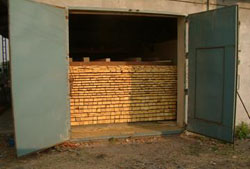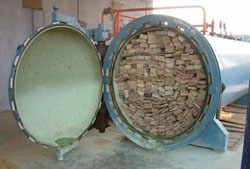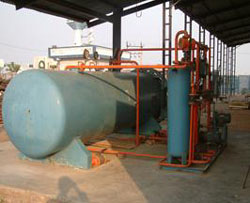Wood processor
Wood, a renewable material, occupies a prime position as a raw material, Its versatile Nature has made it unique in many applications. In most of the uses of wood, longevity of wood is very important.
A large quantity of timber used in India is not properly dried or seasoned & treated resulting into development of defects like warping, cracking, splitting or decay and insect attack in the products.
In Western countries Timber is not allowed to come out from saw mill unless it is seasoned and treated. It is compulsory to season and treat.
Why Seasoning Required ?
Green Wood in growing trees contains considerable quantities of water/moisture. Most of this moisture has to be removed in order to obtain satisfactory performance from the wood in use. Freshly felled wood contains moisture roughly 100 percent based on the oven dry weight of wood. A well seasoned piece of wood should on other hand contain only 10 to 12 percent moisture. An important object of seasoning is to dry the timber to the equilibrium moisture content before use, so that gross dimensional changes through shrinkage, which inevitably occurs in green wood as it tends to attain equillibrium with the surrounding atmosphere, are eliminated.
How Seasoning is done ?
 The method and technology we use is "KILN", which happens to be the most energy intensive amongst wood processing operations claiming an estimated 50-70 percent of the total energy consumed in manufacturing wood products. The timber is stacked in the chamber. Then with Air blower heat exchanges in chamber at pressure. Timber is kept in chamber for 6 to 12 days as per its fiber property. These removes all possible unwanted moisture through fibers.
The method and technology we use is "KILN", which happens to be the most energy intensive amongst wood processing operations claiming an estimated 50-70 percent of the total energy consumed in manufacturing wood products. The timber is stacked in the chamber. Then with Air blower heat exchanges in chamber at pressure. Timber is kept in chamber for 6 to 12 days as per its fiber property. These removes all possible unwanted moisture through fibers.
The seasoning Kiln is a chamber equipped with arrangements for heating and humidifying the drying air to desired conditions of temperature and relative humidity and its circulation over the surfaces of timber stacked inside. Fans are used for faster circulation of air.
Benefits of Seasoning
1. By seasoning timber, "Movement" in the component of the finished products, relative to the dimensions at the time of fabrication, is kept to a minimum. Thus seasoning is the first step towards realising maximum attainable dimensional stability from any timber during use.
2. Considerable losses through cracking, splitting, warping etc, which are liable to occur while using green timber under inevitable exposure to surrounding uncontrolled climatic conditions, are avoided by carrying out proper seasoning under controlled drying conditions prior to use. This is of great importance in timber utilization in India where the climatic conditions vary considerably at different times during the year.
3. Seasoning protects timber against primary decay, fungal stain and attack by certain kinds of insects. The organisms, which cause decay and stain, generally can not thrive in timber with moisture content below 20 percent. Seasoned wood is less susceptible to decay than a green wood in indoor use.
4. Seasoned timber is lighter and hence the transport and handling are easy and the costs are reduced.
5. Seasoned timber is stronger than the green timber in most of the strength properties.
6. Finishing, colouring/painting & gluing is resulted better in seasoned & processed timber than in green wood.
7. The electrical and thermal insulation properties of wood are improved by seasoning.
8. Seasoning enables substantial long-term economy in utilization by minimizing replacement, besides rationalizing the utilization of our timber resources.
Why Chemical Treatment Required ?
 Wood being of organic origin is destroyed by biodegrading agencies such as fungi, insects, termites etc. An untreated non-durable wood may last from 3 to 10 years depending upon its species and use and the hazards it may have to face. Treatment with effective wood preservatives can increase its life from 12 to 50 years. Thus 4 times greater benefit, which is best comparing to the cost of treatment.
Wood being of organic origin is destroyed by biodegrading agencies such as fungi, insects, termites etc. An untreated non-durable wood may last from 3 to 10 years depending upon its species and use and the hazards it may have to face. Treatment with effective wood preservatives can increase its life from 12 to 50 years. Thus 4 times greater benefit, which is best comparing to the cost of treatment.
How Chemical Treatment is done ?
 The efficacy of the preservative treatment depends upon the proper choice of the preservative and the treatment process, which ensures the required absorption and penetration of the preservative. We use the preservatives which are mostly based on their performance under local conditions.
The efficacy of the preservative treatment depends upon the proper choice of the preservative and the treatment process, which ensures the required absorption and penetration of the preservative. We use the preservatives which are mostly based on their performance under local conditions.
The process we used call "Full Cell or Bethel Process". This process is used for maximum absorption of the preservative. In this case the charge is introduced into the cylinder. The thin planks are used to separate the timber to avoid sticking together. The door of cylinder is tightly closed and the vacuum at least 56 cm of mercury is created and maintained for half an hour. The object of this process is to remove as much air as possible from the cells of timber for deeper penetration of preservatives. At the end of process a preservative is introduced into the cylinder, with the vacuum pump working. When the cylinder is filled with preservative the vacuum pump is stopped and the cylinder is subjected to an antiseptic pressure of 3.5 to 12.5 kg/cm2, depending on the species, size, refractory nature of the material etc. This injects the preservative into the timber. The pressure is held until the desired absorption is obtained, after which the preservative is withdrawn from the cylinder and finally a vacuum of 38 to 56 cm of mercury for about 15 minutes is once again applied to making the material free from the dripping preservative.
Benefits of Chemical Treatment (Preservative)
1. As brought out on the onset an untreated non-durable wood may last from 3 to 10 years depending upon its use and the hazards it may have to face. Treatment with effective wood preservatives can increase its life from 10 to 50 years (yes, 4 times).
2. Before applying chemical treatment, vacuuming is done. Vacuuming pulls out all the unwanted moisture from timber. Thus fibers of timber come more closer making timber more harder and denser.
3. Some preservatives used are metallic compounds, whose deep penetration in timber increases its stability. .
4. An untreated timber used in furniture of daily usage last for 15 years. Preservative treatment can enhance its life to more than 50 years.
